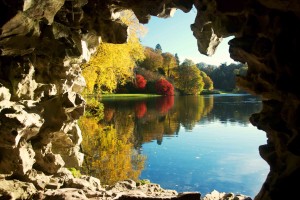
The Grotto at Stourhead offers stunning sightlines into the landscape garden, but needs vital conservation work to remain accessible.
The international success of the English landscape garden movement, whose high water mark was reached in the second half of the 18th century, is reflected in the existence of the French and German labels ‘le jardin anglais’ and ‘der englishe garten.’ Its influence is found in great gardens as far afield as Sweden, Russia and North America. This art form, for it is no less, must rank as one of Great Britain’s greatest cultural exports.
Though neither the largest nor the product of a professional landscapist, the garden at Stourhead, in Wiltshire, ranks amongst the most beautiful and influential of them all. In 1762, Horace Walpole, more often than not scathing or sharp-tongued in the opinions he dealt out, proclaimed: ‘The whole composes one of the most picturesque scenes in the world.’
At the heart of the garden, framed by a 2,500 acre estate of rolling woodland and farmland, lies a 30 acre lake created by the flooding of a steep-sided valley known as Six Wells Bottom. Around its mirror we find a tight, complex landscape, thickly planted with trees and bushes, and adorned with temples and other structures. The views across the lake to and from the points of interest were very carefully devised and controlled. So perfect is this artifice, however, that in walking around the lake’s circuit path or ascending the valley sides, only simplicity and harmony is apparent. Idealized views, as if composed and framed by a master seventeenth-century landscape painter appear and disappear with apparent effortlessness. This is an arcadian, dream-like place, born both of imagination and learning, at once painterly and associative. Here literature, painting, architecture, archaeology, science and religion, were brought together in a sort of Gesamtkunstwerk.
Temples and other garden buildings adorn the ethereal landscape. Now more than 250 years old, these buildings are showing their age and a major campaign of restoration is necessary in order to steer them safely into the future for our successors to enjoy. Two of the most enigmatic of these points of meditation along a visitor’s way are the Grotto on the north side of the lake and the contrasting but complementary Temple of Apollo on its south side. The one sits low in the landscape, riven in the rock above the water’s edge and chthonic in nature; the other crowns an eminence as befits a temple to the Olympian sun god.
The grotto complex, formed of rough rock and pitted tufa, is a cool, dark place filled with the sound of water, and in its half-light we find statues of a sleeping nymph and a river god who represents the Stour.
Before exiting the grotto and emerging blinking into the sunlight, the visitor enjoys a framed view across the water of the Temple of Apollo, hanging on its eminence like the Temple of Vesta at Tivoli. Like Hercules, who takes the hard, rocky and virtuous road up the hill in preference to a seductive life of easy pleasure – the visitor must work hard to ascend to the divine. Built some twenty-five years later, the Temple of Apollo is as sophisticated as the Grotto is consciously rude. A circular peripteral temple whose twelve Corinthian columns support and extraordinary scalloped entablature, it is capped by a double-skinned dome which allows light from an invisible source to pour into the building, illuminating as it does the golden rays and mask of Apollo. Its source is the so-called Temple of Venus at Baalbeck, in Syria an ancient baroque building whose eccentricities were broadcast with the publication of Robert Wood’s The ruins of Balbec, otherwise Heliopolis in Coelosyria, London (1757). As the Earl of Lincoln observed in the year the building was completed, the temple is capable of tricking the senses: ‘When you sit deep within the Temple, you wou’d think it was built close to the Lake , & when you walk round the Latter below, you are almost continually entertaind by the Reflection of it, in the water.’
Both structures are key components of Stourhead’s English Arcadia, a place of international significance and a precious resource for understanding the mindset of its creator, his times, and the phenomenon of the English Landscape Garden.
Stourhead is the site of our 2014 National Trust Appeal. Royal Oak seeks to raise funds for the vital work that is needed on three of these significant garden features: The Temple of Apollo, The Grotto and the Pinetum. Click the button below to learn more and donate.



